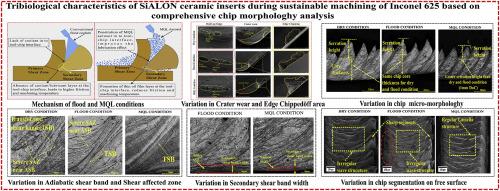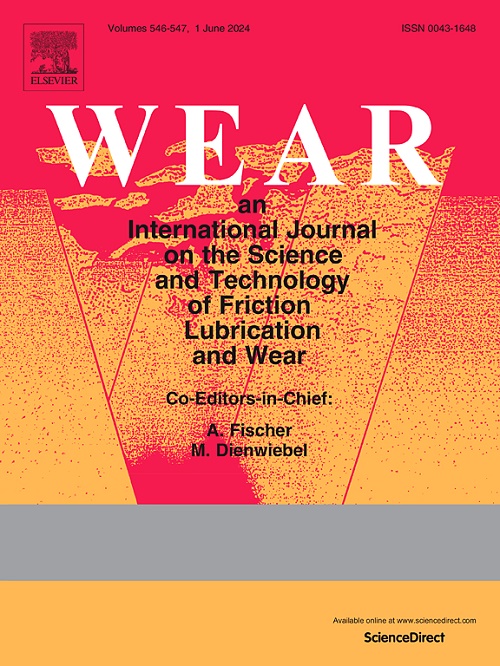Tribological characteristics of SiALON ceramic inserts during sustainable machining of Inconel 625 based on comprehensive chip morphology analysis
IF 5.3
1区 工程技术
Q1 ENGINEERING, MECHANICAL
引用次数: 0
Abstract
The effectiveness of SiALON ceramic inserts during MQL machining of Inconel 625 under different depth of cut (DoC) – 1.00, 1.25, and 1.5 mm - is investigated through tool wear and chip morphology analysis, and compared with dry and flood conditions. Under MQL conditions, the SiALON tools encounter lower wear and edge chipping than both dry and flood conditions for all DoC. The chip serration height, pitch between serrations, adiabatic shear bandwidth (ASB) in the primary as well as the secondary shear zone, and segmentation height on the free surface of the chip are lower for MQL conditions than dry and flood conditions for all DoC. The shear affected zone (SAZ) or transition layer is noticed near the ASB under dry and flood conditions. More transverse shear lines are seen in the vicinity of the ASB under dry and flood conditions for 1.25 mm DoC, indicating a higher degree of plastic deformation. While coarse grains are present near the ASB, the absence of SAZ in the vicinity of the ASB under MQL conditions points to improved cutting zone lubrication and chip removal under MQL. For the first time, the variation in the chip segmentation along the chip width is studied and is also found to be minimal for MQL as compared to dry and flood conditions pointing to the superior penetration capability of MQL deep into the cutting zone.

基于切屑形态综合分析的 SiALON 陶瓷刀片在英科耐尔 625 可持续加工过程中的摩擦学特性
通过刀具磨损和切屑形态分析,研究了 SiALON 陶瓷刀片在不同切削深度 (DoC) - 1.00、1.25 和 1.5 mm - 下对 Inconel 625 进行 MQL 加工时的有效性,并与干式和水浸条件进行了比较。在 MQL 条件下,SiALON 刀具在所有切削深度(DoC)下的磨损和刃口崩裂程度均低于干式和水浸式条件下的磨损和刃口崩裂程度。对于所有 DoC,MQL 条件下的切屑锯齿高度、锯齿间距、主剪切区和次剪切区的绝热剪切带宽 (ASB) 以及切屑自由表面上的分段高度均低于干燥和水浸条件。在干燥和水浸条件下,ASB 附近会出现剪切影响区(SAZ)或过渡层。在 1.25 mm DoC 的干燥和水浸条件下,ASB 附近有更多的横向剪切线,表明塑性变形程度较高。虽然在 ASB 附近存在粗粒,但在 MQL 条件下 ASB 附近没有 SAZ,这表明在 MQL 条件下切削区润滑和排屑得到了改善。我们首次研究了切屑沿切屑宽度的分段变化,发现与干燥和水浸条件相比,MQL 条件下的切屑分段变化极小,这表明 MQL 在切削区深处的穿透能力更强。
本文章由计算机程序翻译,如有差异,请以英文原文为准。
求助全文
约1分钟内获得全文
求助全文
来源期刊

Wear
工程技术-材料科学:综合
CiteScore
8.80
自引率
8.00%
发文量
280
审稿时长
47 days
期刊介绍:
Wear journal is dedicated to the advancement of basic and applied knowledge concerning the nature of wear of materials. Broadly, topics of interest range from development of fundamental understanding of the mechanisms of wear to innovative solutions to practical engineering problems. Authors of experimental studies are expected to comment on the repeatability of the data, and whenever possible, conduct multiple measurements under similar testing conditions. Further, Wear embraces the highest standards of professional ethics, and the detection of matching content, either in written or graphical form, from other publications by the current authors or by others, may result in rejection.
 求助内容:
求助内容: 应助结果提醒方式:
应助结果提醒方式:


